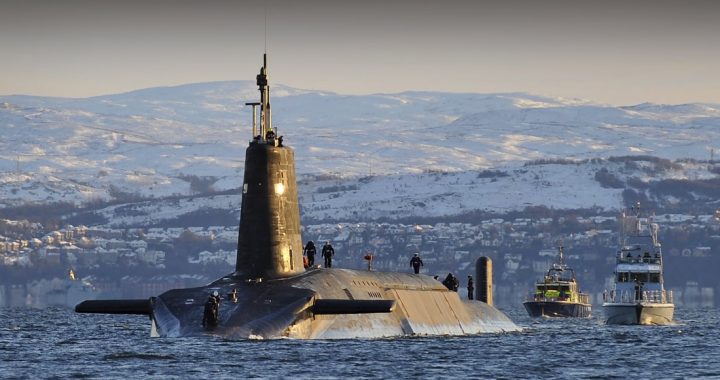By Leonard Eiger
February 2, 2023
Imagine if you will. Down in the murky depths of the Atlantic Ocean two nuclear powered ballistic missile submarines, one British and the other French, are on patrol. These huge, yet nimble giants (roughly the length of one and a half football fields), with some of the most advanced technology available, are bristling with nuclear armed missiles (each one with enough megatonage to incinerate much of a large continent – think RUSSIA). Their crews monitor the waters around them as they cruise silently (very, very silently), deep beneath the surface.
Wham!!! The next you know, it’s general quarters with klaxons clanging and sailors frantically securing hatches, determining the extent of damage, and generally trying to figure what the hell just happened. Crew members have lots of things on their minds, not the least of which are the condition of the nuclear reactor as well as the 16 nuclear armed missiles, each loaded with a whole bunch of thermonuclear warheads, nestled in their launch tubes, not to mention whether they will ever see sunlight again.
When the dust settles everybody takes a deep breath, while somebody asks about their insurance carrier. They have just had the most expensive fender bender in history. By now you might be wondering whether this is fact or fiction… FACT!
Sometime during the night – and quite literally like ships in the night – between February 3 and 4, 2009 the British submarine HMS Vanguard collided with the French submarine Le Triomphant in the Bay of Biscay. The damage to Le Triomphant’s front end (the sonar dome to be precise) has been estimated at roughly $73 million; good thing it was a “low speed” collision (according to France’s defense ministry). The UK Ministry of Defence said it’s submarine was travelling “at very low speed”. Both submarines are equipped with active and passive sonar, although only the latter is used on an operational patrol. Thank God for five mile-an-hour bumpers.
And that’s not all. They didn’t know they had hit each other. The French sub commander immediately surfaced and radioed that “I have hit something. I think it was a [shipping] container, so I am heading back to Brest.” I am sure the British would get a little huffy having the French refer to one of their Trident subs as a shipping container; after all, the British are “shipping” the same Trident missiles as American Trident submarines. So much for international relations.
According to one report, the Vanguard received damage to the outer casing in the area of the missile compartment on the starboard (right) side. Another reported that its conning tower was damaged. Le Triomphant was said to have received damage to the active sonar dome under the bow. This would indicate that Le Triomphant ran into Vanguard from above.
Both submarines limped back home. Fortunately for both crews, there were evidently no injuries, and neither the pressure hulls, the reactors, nor the nuclear weapons were compromised. But what if??? What if the submarines had been moving at a higher rate of speed and one impacted the other amidship? One expert quoted said that, “It’s like two blindfolded men creeping around a room. Eventually they are going to bump into each other.” Isn’t it more like blind people driving two big diesel trucks containing sensitive, high explosives around a parking lot?
What ended up being an embarrassing and very expensive accident might have been a catastrophe. As for the probability of this event, the Daily Mail Online quoted “naval sources” as saying “it was a million to one unlucky chance both subs were in the same patch of sea.” That, in itself, is a very important statement. Everything carries some risk. There is no such thing as absolute safety. In terms of the potential for a collision between two nuclear submarines, or even an accidental detonation of a nuclear weapon, there is always some risk, whether due to a problem with the weapon or human error. And even when that risk is infinitesimal, as in the case of one chance in a million, there is still (always) that minute probability of failure or accident. In the case of an accident involving the detonation of a nuclear weapon (or perhaps an accidental launch), is that a risk we can consider acceptable?
These two subs were cruising around on what the French defence ministry called their “nuclear deterrence missions”. One has to wonder what these behemoths (loaded with the most destructive force the world has ever known) present – a deterrent or a liability. In a post Cold War world, big submarines loaded with nuclear armed missiles are, indeed, an impressive (and expensive) show of force. But what is their practicality? How much of a deterrent are they in the new world order? Consider the possibility of a US and Russian submarine colliding under the current tensions surrounding the Russian war on Ukraine. Are these denizens of the deep perhaps dinosaurs destined for extinction? Or… are we???
Note: The banner photo has been corrected to show the HMS Vanguard, which was involved in the collision with Le Triumphant. The original photo posted was of the USS Los Angeles, a nuclear attack submarine, which was involved in a separate and serious accident in 2005 in which it collided head-on with an undersea mountain.
References:
Nuclear subs collide in Atlantic; BBC; February 16, 2009; http://news.bbc.co.uk/1/hi/uk/7892294.stm
French and British Submarines Collide; New York Times; February 16, 2009;https://www.nytimes.com/2009/02/17/world/europe/17submarine.html?_r=1&hp
Nuclear submarines collide in Atlantic; The Guardian; February 16, 2009;https://www.theguardian.com/uk/2009/feb/16/nuclear-submarines-collide
How close did crash submarines packed with nuclear missiles come to disaster?; Daily Mail; February 17, 2009;https://www.dailymail.co.uk/news/article-1146124/How-close-did-crash-submarines-packed-nuclear-missiles-come-disaster.html
HMS Vanguard and Le Triomphant submarine collision; https://military-history.fandom.com/wiki/HMS_Vanguard_and_Le_Triomphant_submarine_collision




